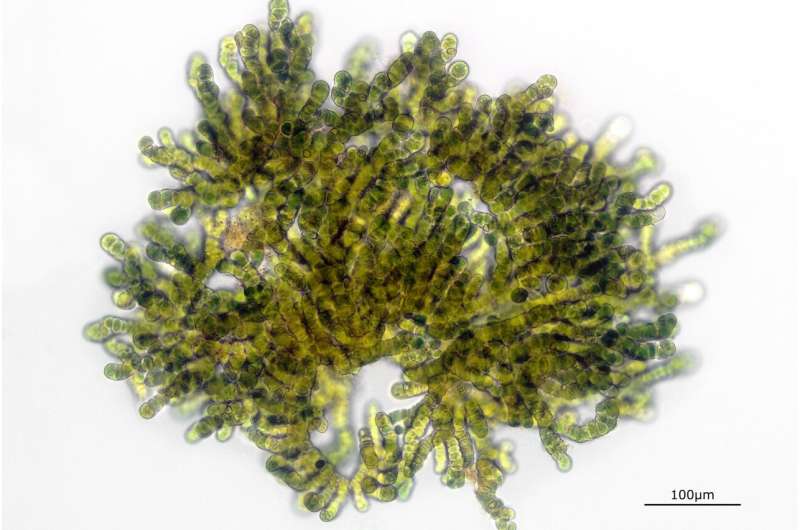This article has been reviewed according to Science X's editorial process and policies. Editors have highlighted the following attributes while ensuring the content's credibility:
fact-checked
peer-reviewed publication
proofread
Double trouble: Infamous 'eagle killer' bacterium produces not one, but two toxins

The cyanobacterium Aetokthonos hydrillicola produces not just one, but two highly potent toxins. In the latest issue of the journal Proceedings of the National Academy of Sciences (PNAS), an international team led by Martin Luther University Halle-Wittenberg (MLU) and Freie Universität Berlin describes the second toxin, which had remained elusive until now.
Even in low concentrations, this toxin can destroy cells and is similar to substances currently used in cancer treatment. Two years ago, the same team established that the first toxin from the cyanobacterium is the cause of a mysterious disease among bald eagles in the USA.
Aetokthonos hydrillicola is particularly challenging for researchers. It is notoriously difficult to cultivate and produces one of its toxins only under specific conditions. The fact that it produces two toxins with very different chemical makeups is also unusual. Cyanobacteria normally produce only one toxin—and A. hydrillicola was established as the source of aetokthonotoxin in 2021. This discovery was made by Professor Susan Wilde from the University of Georgia (USA) and Professor Timo Niedermeyer, who worked at MLU until July 2023 and has now joined the researchers at Freie Universität Berlin.
This toxin solved a riddle that had kept scientists busy for decades: it triggers the disease vacuolar myelinopathy (VM) among bald eagles in the United States. VM causes holes to form in the brain and, as a result, the birds lose control of their bodies. Science ran the breakthrough as a cover story at the time, and the international team picked up several awards for its work.
Markus Schwark from MLU was able to provide evidence of the second, previously unknown toxin and characterized the compound in detail. "We were very surprised when we worked out the structure of this toxin. It resembles toxins that have been found in marine cyanobacteria. They are even already being used in cancer-cell killing drugs," says Schwark. Based on the bacterium and the similar, known toxins, the researchers have named the newly discovered toxin "aetokthonostatin."
Scientists have suspected that this toxin exists for some time. "During one of our first investigations over ten years ago, we discovered that an extract of the cyanobacterium is highly toxic for cells. We assumed that this effect points to aetokthonotoxin that triggers the avian disease," says Timo Niedermeyer.
However, further examinations revealed that the bird toxin only causes minor direct cell damage. Extracts with zero aetokthonotoxin content still destroyed cells even in extremely low concentrations. So A. hydrillicola had to be producing another very powerful toxin.
A team from the Czech Academy of Sciences led by Dr. Jan Mareš was able to determine which genes in the cyanobacterium are behind the synthesis of the new toxic molecule. Since the compound is similar to substances that are used in antitumor medicine, the findings could help to develop new drugs that fight cancer.
The cyanobacterium is also thriving in American lakes and rivers that feed the drinking water network. The scientists therefore recommend monitoring these waters more frequently for Aetokthonos hydrillicola and its two toxins to avoid potential risks to human health.
More information: Markus Schwark et al, More than just an eagle killer: The freshwater cyanobacterium Aetokthonos hydrillicola produces highly toxic dolastatin derivatives, Proceedings of the National Academy of Sciences (2023). DOI: 10.1073/pnas.2219230120
Journal information: Proceedings of the National Academy of Sciences
Provided by Martin Luther University Halle-Wittenberg




















